Excerpts from Jim Conrad's
Naturalist Newsletter
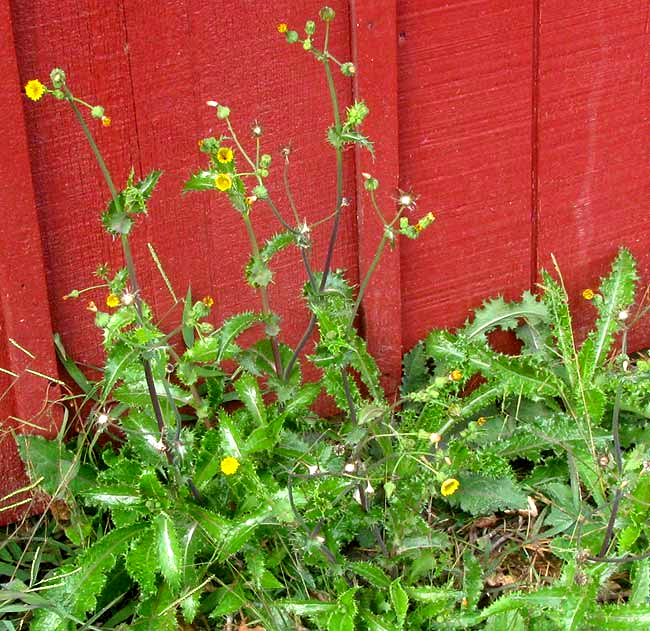
from the December 9, 2012 Newsletter issued from the valley of the Dry Frio River in northern Uvalde County, southwestern Texas, on the southern border of the Edwards Plateau; elevation ~1750m (~5750 ft); N29.62°, W99.86°; USA
PRICKLY SOW THISTLE FLOWERING
Just a month ago so many wildflowers and weeds were flowering that I thought that maybe all through winter we'd have at least a few flowering plants to look at, since we're so far south. However, despite our not yet having had a hard frost, suddenly there's very little blossoming now. One big exception -- and this because it's growing against the south-facing wall of the cabin where the temperature averages a lot warmer -- is the knee-high, annual or biennial herb shown above.
That's the Prickly Sow Thistle, also called Spiny Leaf Sow Thistle, SONCHUS ASPER. This plant's spiny leaf margins help us identify it, as well as its composite-type flower heads, which look like small Dandelion heads, as shown below:
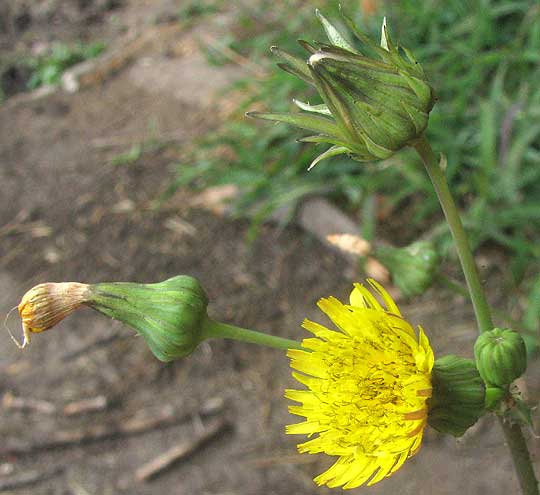
In that picture you see that this is one of that subgroup of Composite Family members, along with Dandelions, in which the flower heads are composed only of flat, petal-like "ray flowers." Most composite flower heads are a mixture of flat ray flowers and cylindrical disk flowers, and some, like the Eupatoriums, have only disk flowers. In the above picture, the head at the far left has flowered and the ray flowers are turning brown, while the urn-shaped collection of scales or bracts enveloping the flowers' bases -- the involucre -- protects the developing cypsela-type fruits. At the top of the picture another flower head is even more mature, the involucre about ready to open up and release the cypselae into the wind, the fruits being equipped with hair-parachutes, again like Dandelion fruits.
A longitudinal sections of a flower head showing white, developing fruits at the bottom of each flower, and white hairs that later will form the parachute that will carry the fruits on the wind, plus the ray flowers' yellow corollas and the wiry, curly style branches is shown below:
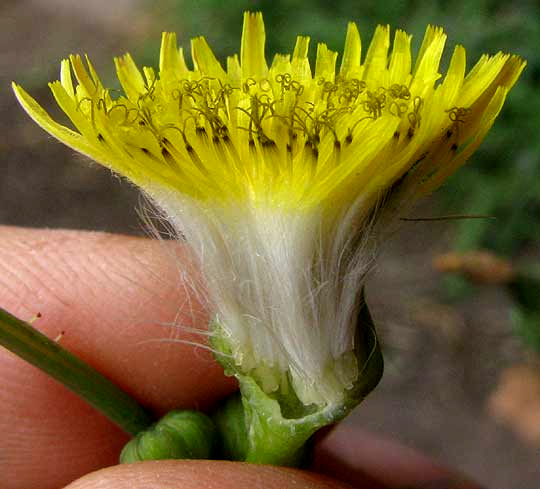
Our Prickly Sow Thistle is one of two similar sow thistle species -- members of the genus Sonchus -- commonly found growing weedily in all but northernmost North America. Both are invasive species from Europe, and both now have spread into weedy places pretty much worldwide. The other species, Sonchus oleraceous, often is called the Common Sow Thistle, though in our part of the world the Spiny Leaf Sow Thistle seems more common than the Common. The prickles on our Prickly Sow Thistle are so stiff and sharp that if you grasp a leaf it can hurt. The Common Sow Thistle's leaf spines aren't as stiff and hurtful. The other good field mark differentiating the two species is shown below:
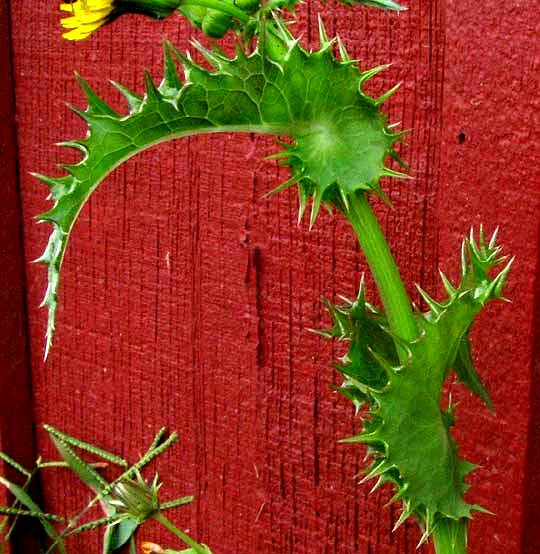
Notice that where each leaf meets the stem the blade bottom enlarges and curls around into an ear-like lobe, or "auricle." Both of the common, weedy sow thistle species bear spiny-margined leaves with auricles, but our Prickly Sow Thistle's auricles are rounded, as shown, while the Common Sow Thistle's auricles are variously shaped, sometimes a bit triangular, but not consistently rounded.
Having such a lush bounty of Prickly Sow Thistles beside the cabin I couldn't resist picking a mess of young leaves and sprouts, and cooking them. The spines on young leaves, once they're cooked, aren't noticeable when you eat the leaves. The leaves cook down to a soft pulp like cooked spinach. Remembering that some potent alkaloids occur among the milkweeds, I threw away the water the greens were cooked in, though with turnip greens and the like I drink that water. Cooked sow thistle tastes good, wholesome, maybe like picked roadside dock.
I read that traditionally Prickly Sow Thistle has been pounded and applied as a poultice to wounds and boils. A research paper out of Pakistan asserts that Sonchus asper possesses antioxidant capacity and is used in liver and kidney disorders. It was found that a methanolic extract of Sonchus asper "ameliorated the oxidative damage and had increased the regenerative and reparative capacity of liver and kidneys." That paper is freely available at http://www.biomedcentral.com/1472-6882/11/113.
from the March 24, 2013 Newsletter issued from the valley of the Dry Frio River in northern Uvalde County, southwestern Texas, on the southern border of the Edwards Plateau; elevation ~1750m (~5750 ft); N29.62°, W99.86°; USA
EATING PRICKLY SOW THISTLE
All winter little rosettes of Prickly Sow Thistle leaves speckled the ground next to the cabin. With warmer weather the leaves expanded rapidly and now some plants are about knee high, producing yellow, dandelion-like flowers and white, puffball heads of parachuted, achene-type fruits. Most plants, however, are only about a foot tall or smaller, without flowers or fruits. Thing is, such foot-tall plants are perfect for harvesting to eat. One of them is shown below:
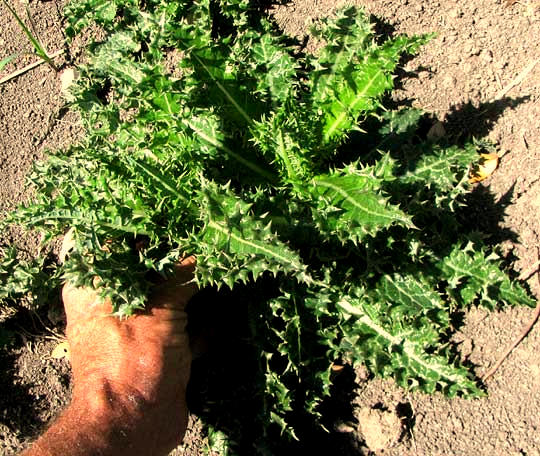
A salad bowl heaped with freshly cut sow thistles is shown below:
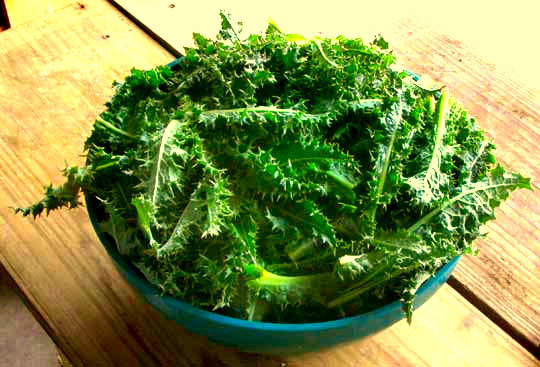
And an afternoon snack of sow thistle greens accompanied by mashed potatoes and salad made from garden pickings and sprouted lentils is on display below:
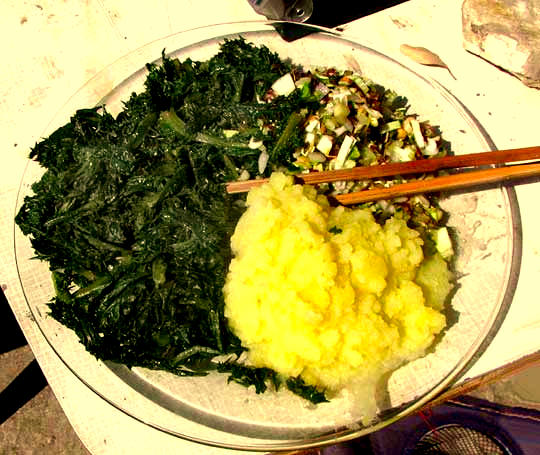
Picking Prickly Sow Thistle is ticklish because the leaves' spines are just hard enough to cause discomfort, but not hard enough to stick you. With cooking they become so tender that in the mouth you hardly notice them. Cooked sow thistle is very much like cooked kale, and I prepare it the same way:
Sprinkle them with a pinch of salt and pepper, pile them on a plate, top it with some margarine while it's still hot, and eat.
You can just feel vivacious nutrients streaming into the body, and the stomach saying "thank you."